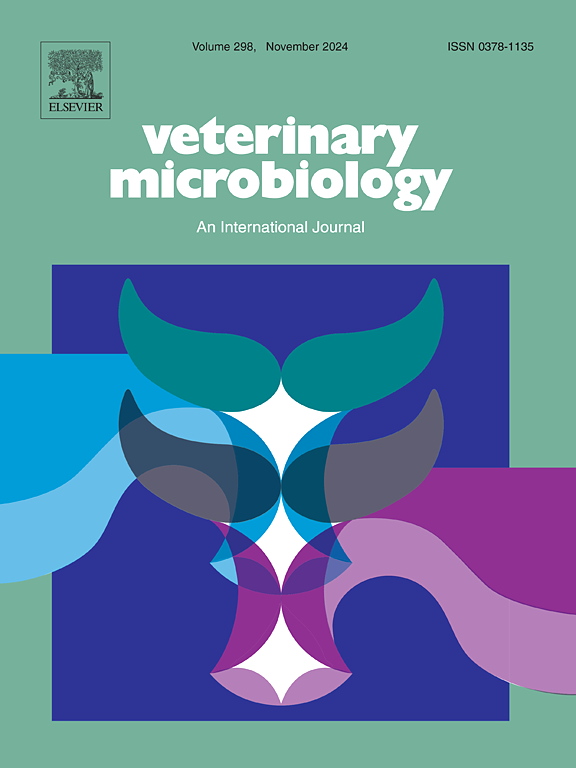Bacteria associated with canine pyometra and concurrent bacteriuria: A prospective study
IF 2.4
2区 农林科学
Q3 MICROBIOLOGY
引用次数: 0
Abstract
Canine pyometra is a common and potentially life-threatening reproductive disorder in intact female dogs. This prospective study aimed to (1) investigate the bacterial spectrum and antimicrobial susceptibilities of bacterial isolates from the uterus and urine of dogs with pyometra, (2) assess the clonal relatedness and virulence factors of Escherichia coli isolates from individual dogs, and (3) determine the occurrence of concurrent and persistent bacteriuria or clinical urinary tract infections. Bacterial isolates from 208 uterine and 203 urine specimens collected during pyometra surgery were analyzed. Additionally, follow-up urine specimens were collected from 56 dogs with perioperative bacteriuria. Bacterial growth was detected in 87 % (180/208) of uterine specimens, while concurrent bacteriuria was observed in 33 % (67/203) of cases. In one-third (18/56) of these dogs the bacteriuria persisted, being primarily (15/18) asymptomatic. E. coli was the most common isolate in both uterine (71 %) and urine (81 %) specimens. Notably, altogether 32 distinct bacterial species were identified, with mixed growth in 15 % of the specimens. The vast majority of isolates were largely susceptible to tested antimicrobials. Identification of bacterial species was performed using MALDI-ToF MS, and antimicrobial susceptibility was assessed by disk diffusion. Whole-genome sequencing of 45 E. coli strains from fifteen dogs indicated high genetic similarities within individual dogs, supporting a clonal relationship. In conclusion, canine uteri with pyometra contained a plethora of bacterial species, predominantly E. coli, and antimicrobial resistance was rare. Concurrent and persistent E. coli bacteriuria was commonly caused by the same clone as found in the uterus.
与犬脓脓相关的细菌和并发细菌尿:一项前瞻性研究。
犬脓脓症是一种常见的和潜在的危及生命的生殖障碍在完整的母狗。本前瞻性研究旨在(1)调查脓脓狗子宫和尿液中分离细菌的细菌谱和抗菌药物敏感性,(2)评估犬个体大肠杆菌分离株的克隆相关性和毒力因子,(3)确定并发和持续性细菌尿或临床尿路感染的发生情况。对子宫脓膜术中采集的208份子宫标本和203份尿液标本进行细菌分离分析。并收集56只围手术期细菌尿犬的随访尿液标本。87 %(180/208)的子宫标本检出细菌生长,33 %(67/203)的子宫标本检出并发菌尿。三分之一(18/56)的狗持续存在细菌尿,主要(15/18)无症状。大肠杆菌是子宫(71 %)和尿液(81 %)中最常见的分离物。值得注意的是,总共鉴定出32种不同的细菌,在15. %的标本中混合生长。绝大多数分离株在很大程度上对测试的抗菌素敏感。采用MALDI-ToF质谱法鉴定细菌种类,采用纸片扩散法评价药敏。来自15只狗的45株大肠杆菌的全基因组测序表明,单个狗的遗传相似性很高,支持克隆关系。结论:脓脓的犬子宫中含有大量细菌,主要是大肠杆菌,抗菌药物耐药性罕见。并发和持续性大肠杆菌尿通常是由子宫内发现的同一克隆引起的。
本文章由计算机程序翻译,如有差异,请以英文原文为准。
求助全文
约1分钟内获得全文
求助全文
来源期刊

Veterinary microbiology
农林科学-兽医学
CiteScore
5.90
自引率
6.10%
发文量
221
审稿时长
52 days
期刊介绍:
Veterinary Microbiology is concerned with microbial (bacterial, fungal, viral) diseases of domesticated vertebrate animals (livestock, companion animals, fur-bearing animals, game, poultry, fish) that supply food, other useful products or companionship. In addition, Microbial diseases of wild animals living in captivity, or as members of the feral fauna will also be considered if the infections are of interest because of their interrelation with humans (zoonoses) and/or domestic animals. Studies of antimicrobial resistance are also included, provided that the results represent a substantial advance in knowledge. Authors are strongly encouraged to read - prior to submission - the Editorials (''Scope or cope'' and ''Scope or cope II'') published previously in the journal. The Editors reserve the right to suggest submission to another journal for those papers which they feel would be more appropriate for consideration by that journal.
Original research papers of high quality and novelty on aspects of control, host response, molecular biology, pathogenesis, prevention, and treatment of microbial diseases of animals are published. Papers dealing primarily with immunology, epidemiology, molecular biology and antiviral or microbial agents will only be considered if they demonstrate a clear impact on a disease. Papers focusing solely on diagnostic techniques (such as another PCR protocol or ELISA) will not be published - focus should be on a microorganism and not on a particular technique. Papers only reporting microbial sequences, transcriptomics data, or proteomics data will not be considered unless the results represent a substantial advance in knowledge.
Drug trial papers will be considered if they have general application or significance. Papers on the identification of microorganisms will also be considered, but detailed taxonomic studies do not fall within the scope of the journal. Case reports will not be published, unless they have general application or contain novel aspects. Papers of geographically limited interest, which repeat what had been established elsewhere will not be considered. The readership of the journal is global.
 求助内容:
求助内容: 应助结果提醒方式:
应助结果提醒方式:


